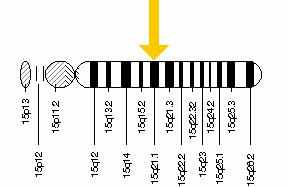Marfan Syndrome
Marfan Syndrome is one of the greatest dangers to tall people, mainly because it’s symptoms are so often overlooked, even by trained professionals.
Unchecked, Marfan can result in serious injury and even death. There have been documented cases of professional athletes, under continuous medical supervision, who have died of complications of Marfan, such as a ruptured aorta or mitral valve prolapse.
Marfan is the result of a genetic defect, but only about 75% of cases are inherited, the rest result from “spontaneous mutation”. About one in 5,000 persons has the defect.
The gene is on chromosome 15q.

Symptoms can occur throughout the body, and not all people with Marfan have all the symptoms. Marfan can affect the skeleton, eyes, lungs, heart and even the teeth of an affected individual.
The most serious problems associated with Marfan syndrome involve the cardiovascular system. The two leaflets of the mitral valve may billow backwards when the heart contracts, a condition called "mitral valve prolapse". This feature may lead to heart failure or be associated with irregularities of the heart rhythm. The aorta (the main artery carrying blood away from the heart) is generally wider and more fragile in people with the Marfan Syndrome. This widening is progressive and may result in leakage of the aortic valve or in the development of tears in the wall of the aorta.
Another concern is the lungs: spontaneous pneumorthorax (collapse of the lungs) is thought to occur in approximately 10% of patients and requires hospital treatment.
How do I know if I have it?
Accurate diagnosis requires a doctor experienced in Marfan Syndrome. It is not usually detected in a routine physical. Special tests such as an Echocardiogram (not the same as an Electrocardiogram) and specialized genetic tests are required.
You should seek out a specialist if you have several of the following:
- Eyes: myopia (nearsightedness); subluxation or dislocation of the lens; unstable refraction; detachment of the retina; strabismus; glaucoma.
- Teeth: high-arched palate, crowding of the teeth.
- Heart: dilatation of the ascending and sometimes the descending aorta; incompetence of the aortic and mitral valves; aneurysm and dissection of the aorta.
- Skeleton: tall thin physique; disproportionately long limbs; fingers and toes; loose ankles; flat feet; spinal curvature; abnormally shaped chest (with pigeon or funnel deformity); arm span usually greater than height; loose or exceptionally mobile joints or contractures.
It’s important to note that simply being tall, thin and nearsighted does not mean you have Marfan, but you might want to talk with your physician about it.
What do I do if I have it?
Marfan Syndrome is a variable disorder, affecting each patient differently. No web site is going to give you all the information you need to handle your specific situation.
Lifestyle adaptations, such as the avoidance of strenuous exercise and contact sports, are often necessary to reduce the risk of injury to eyes and skeleton as well as the aorta. Beta blockers have been shown to slow the dilation of the aortic root and their use should be considered in all patients. Regular Echocardiograms are important to monitor size and function of the heart and aorta.
People with Marfan should stop smoking. Smoking destroys elastin, which is the very protein already deficient in anyone who has Marfan Syndrome.
For more information on Marfan Syndrome visit:
